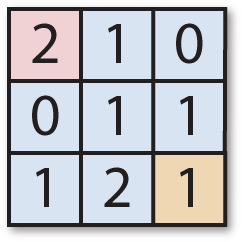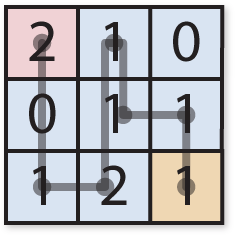
Math Trivia
Wednesday, December 12, 2012
Math Game

Damath is a board game that comes from the Philippines, and is used as a teaching tool for high school mathematics.
Math Terms
Acute angle – An angle which measures below 90°.
Acute triangle – A triangle containing only acute angles.
Additive inverse – The opposite of a number or its negative. A number plus its additive inverse equals 0.
Adjacent angles – Angles with a common side and vertex.
Angle – Created by two rays and containing an endpoint in common.
Arc – A set of points that lie on a circle and that are positioned within a central angle.
Area – The space contained within a shape.
Average – The numerical result of dividing the sum of two or more quantities by the number of quantities.
Binomial – An expression in algebra that consists of two terms.
Bisect – To divide into two equal sections.
Canceling – In multiplication of fractions, when one number is divided into both a numerator and a denominator.
Cartesian coordinates – Ordered number pairs that are assigned to points on a plane.
Chord – A line segment that connects two points on a circle.
Circle – A set of points that are all the same distance from a given point.
Circumference – The distance measured around a circle.
Coefficient – A number that is placed in front of a variable. For example, in 6x, 6 is the coefficient.
Common denominator – A number that can be divided evenly by all denominators in the problem.
Complementary angles – Two angles in which the sum of their measurements equals 90°.
Complex fraction – A fraction that contains a fraction or fractions in the numerator and/or denominator.
Congruent – Exactly the same. Identical in regard to size and shape.
Coordinate graph – Two perpendicular number lines, the x axis and the y axis, which make a plane upon which each point is assigned a pair of numbers.
Cube – A solid with six sides, with the sides being equal squares and the edges being equal. Also, the resulting number when a number is multiplied by itself twice.
Cube root – A number that when multiplied by itself twice gives the original number. For example, 4 is the cube root of 64.
Decimal fraction – Fraction with a denominator of 10, 100, 1,000, etc., written using a decimal point.
Degree – The measurement unit of an angle.
Denominator – The bottom symbol or number of a fraction.
Diameter – A line segment that contains the center and has its endpoints on the circle. Also, the length of this segment.
Difference – That which results from subtraction.
Math Song
LITTLE BOOTS LYRICS
"Mathematics"
Mathematics is a difficult thing
I never understood what was the missing link
And by the time I'd calculated the correct solution
The question had escaped me and so did the conclusion
So tell me, everything must always be for two
Or nothing else is true and I'll believe you
Cos your X is equal to my Y but equations pass me by
So will you take just a little of my mind
And subtract it by my soul
Add a fraction of your heart
And you'll see it makes me whole
Multiply it by the times that we've never been apart
You'll see nothing can divide just a heart plus a heart
A little of my mind
Take it from my soul
A fraction of your heart
See it makes me whole
And multiply the times, we'll never be apart
Cos nothing can divide a heart plus a heart
Don't know my Fibonacci or Pythagoras
But the only formula I know will work for us
Is that when we're together in the sum of our parts
It's more greater than what we added up to at the start
So tell me, everything must always be for two
Or nothing else is true and I'll believe you
Cos your X is equal to my Y but equations pass me by
So will you take just a little of my mind
And subtract it by my soul
Add a fraction of your heart
And you'll see it makes me whole
Multiply it by the times that we've never been apart
You'll see nothing can divide just a heart plus a heart
A little of my mind
Take it from my soul
A fraction of your heart
See it makes me whole
And multiply the times, we'll never be apart
Cos nothing can divide a heart plus a heart
A heart plus a heart
Take just a little of my mind
And subtract it by my soul
Add a fraction of your heart
And you'll see it makes me whole
Multiply it by the times that we've never been apart
You'll see nothing can divide just a heart plus a heart
A little of my mind
Take it from my soul
A fraction of your heart
See it makes me whole
And multiply the times, we'll never be apart
Cos nothing can divide a heart plus a heart
I never understood what was the missing link
And by the time I'd calculated the correct solution
The question had escaped me and so did the conclusion
So tell me, everything must always be for two
Or nothing else is true and I'll believe you
Cos your X is equal to my Y but equations pass me by
So will you take just a little of my mind
And subtract it by my soul
Add a fraction of your heart
And you'll see it makes me whole
Multiply it by the times that we've never been apart
You'll see nothing can divide just a heart plus a heart
A little of my mind
Take it from my soul
A fraction of your heart
See it makes me whole
And multiply the times, we'll never be apart
Cos nothing can divide a heart plus a heart
Don't know my Fibonacci or Pythagoras
But the only formula I know will work for us
Is that when we're together in the sum of our parts
It's more greater than what we added up to at the start
So tell me, everything must always be for two
Or nothing else is true and I'll believe you
Cos your X is equal to my Y but equations pass me by
So will you take just a little of my mind
And subtract it by my soul
Add a fraction of your heart
And you'll see it makes me whole
Multiply it by the times that we've never been apart
You'll see nothing can divide just a heart plus a heart
A little of my mind
Take it from my soul
A fraction of your heart
See it makes me whole
And multiply the times, we'll never be apart
Cos nothing can divide a heart plus a heart
A heart plus a heart
Take just a little of my mind
And subtract it by my soul
Add a fraction of your heart
And you'll see it makes me whole
Multiply it by the times that we've never been apart
You'll see nothing can divide just a heart plus a heart
A little of my mind
Take it from my soul
A fraction of your heart
See it makes me whole
And multiply the times, we'll never be apart
Cos nothing can divide a heart plus a heart
Math Puzzle
Jumping puzzle
These mazes are based on the idea that you can jump the specified number of steps in any direction, horizontally or vertically.Here's a simple example. Start at the 2 in the top left-hand corner, and find a route to the 1 in the bottom right-hand corner:
 From the starting square you can move right to the 0 in the top row, or down to the 1 in the leftmost column. Then from the 1 you can move up to the 0 above it, or right to the 2 in the bottom row, and so on. Here's the full six-step solution:
From the starting square you can move right to the 0 in the top row, or down to the 1 in the leftmost column. Then from the 1 you can move up to the 0 above it, or right to the 2 in the bottom row, and so on. Here's the full six-step solution: http://www.mazelog.com/show?7
http://www.mazelog.com/show?7Monday, December 10, 2012
Math Trivia
Math trivias
Did you know?
Did you know?
- October 10th is National Metric Day.
- national Pi Day is March 14 at 1:59. (Get it? 3/14 1:59
- If you add up the numbers from 1 to 100 (1+2+3+...+100)the sum is 5050.
- The first prime number after 1,000,000 is 1,000,003.
- 111,111,111 x 111,111,111 = 12,345,678,987,654,321.
- A jiffy is actually a unit of time. It is 1/100 of a second.
Subscribe to:
Comments (Atom)